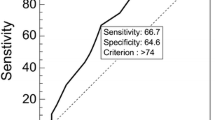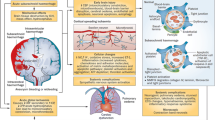Summary
The prognostic value of the level of consciousness and the patient's age for the outcome of aneurysmal subarachnoid haemorrhage (SAH) is studied in 74 patients admitted on day (D)0 to D3 after aneurysm rupture.
For the level of consciousness three groups of patients are compared: grade I+II (alert patients), grade III+IV (drowsy patients), and grade V (comatose patients). For the age, two groups are compared: patients aged under 50, and patients aged 50 and over. The timing of surgery was: D0–D3 51%, D4–D6 20%, D7 and later 18%, and No surgery 11%.
The overall management results were: Good (satisfactory result) 43%, Fair (moderately disabled) 18%, Poor (severely disabled+vegetative survival) 19%, and Death 20%. The outcome was strongly related to the level of consciousness, the rates of Good result decreasing from 71% (grades I–II) to 14% (grades III–IV) and to zero (grade V), and the mortality rates increasing respectively from 5% to 14% and 61%.
The relationship between outcome and age was less marked: 54% Good result under 50 and 30% over 50. Out of the Grade V group, 56% could be operated upon and 44% died before surgery. No patient from the other two groups died before surgery. The literature concerning the Grading Systems published so far and the various prognostic factors are discussed.
Similar content being viewed by others
References
Botterel EH, Lougheed WM, Scott JW, Van Den Waper SL (1956) Hypothermia and interruption of carotid and vertebral circulation, in the surgical management of intracranial aneurysms. J Neurosurg 13: 1–42
Dautheribes M, Boulard G, Guerin J, Leman P (1985) Hémorragies sous arachnoïdiennes spontanées. Plaidoyer pour un système standard d'évaluation. Neurochirurgie 31: 37–40
Deruty R, Mottolese C, Pelissou-Guyotat I, Soustiel JF (1991) Management of the ruptured intracranial aneurysm. Early surgery, late surgery, or modulated surgery? Acta Neurochir (Wien) 113: 1–10
Drake CG, Hunt WE, Sano K, Kassel N, Teasdale G, Pertuiset B, Devilliers JC (1988) Report of World Federation of Neurological Surgeons Committee on a Universal Subarachnoid Haemorrhage Grading Scale. J Neurosurg 68: 985–986
Gerber CJ, Lang DA, Neil-Dwyer G, Smith PWF (1993) A simple scoring system for accurate prediction of outcome within four days of a subarachnoid haemorrhage. Acta Neurochir (Wien) 122: 11–22
Hernesniemi J, Vapalathi M, Niskanen M, Tapaninaho A, Kari A, Luukkonen M, Puranen M, Saari T, Pajpar M (1993) One-year outcome in early aneurysm surgery: a 14-year experience. Acta Neurochir (Wien) 122: 1–10
Hunt WE, Hess RM (1968) Surgical risk as related to time of intervention in the repair of intracranial aneurysm. J Neurosurg 28: 14–19
Hunt WE, Kosnik EJ (1974) Timing and perioperative care in intracranial aneurysm surgery. Neurosurgery 21: 79–89
Hunt WE, Kassell N, Pertuiset B, Sano K, Teasdale G, de Villier JC, Drake CG (1988) Report of the World Federation of Neurological Surgeons Committee on a Universal Subarachnoid Hemorrhage Grading Scale. J Neurosurg 68: 985–986
Inagawa T. (1993) Management outcome in the elderly patients following subarachnoid hemorrhage. J Neurosurg 78: 554–561
Jennet B, Teasdale G, Braaman R, Minderhood J, Knill-Jones RP (1976) Predicting outcome in individual patients after severe head injury. Lancet 1: 1031–1034
Kassel NF, Torner JC, Haley EC, Jane JA, Adams HP, Kongable GL, (1990) The international cooperative study on the timing of aneurysm surgery. Part 1: overall management results. J Neurosurg 73: 18–36
Lindsay KW, Teasdale G, Knill-Jones RP, Murray C (1982) Observer variability in grading patients with subarachnoid hemorrhage. J Neurosurg 56: 628–633
Lindsay KW, Teasdale G, Knill-Jones RP (1983) Observer variability in assessing the clinical features of subarachnoïd hemorrhage. J Neurosurg 58: 57–62
Miyaoka M, Sato K, Ishii S (1993) A clinical study of the relationship of timing to outcome of surgery for ruptured cerebral aneurysms. A retrospective analysis of 1622 cases. J Neurosurg 79: 373–378
Nishioka H (1969) Report on the cooperative study of intracranial aneurysms and subarachnoïd hemorrhage. Section VII. Part I. Evaluation of conservatory management for ruptured intracranial aneurysms. J Neurosurg 25: 574–592
Niskanen MM, Herniesniemi JA, Vapalahti MP, Kari A (1993) One year outcome in early aneurysm surgery: prediction of outcome. Acta Neurochir (Wien) 123: 25–32
Sano K (1983) Cerebral vasospasm and aneurysm surgery. Clin Neurosurg 30: 13–58
Sano K, Tamura A (1985) A proposal for grading of SAH haemorrhage due to aneurysm rupture. In: Auer LM (ed) Timing of aneurysm surgery, de Grueyter, Berlin, pp 3–7
Saveland H, Hillman J, Brandt L, Edner G, Jakobsson KE, Algers G (1992) Overall outcome in aneurysmal subarachnoid hemorrhage. (A prospective study from neurosurgical units in Sweden during a 1-year period). J Neurosurg 76: 729–734
Tamura A (1987) Grading risk, angiography and computerized tomography. A grading system. In: Sano K, Asano T, Tamura A (eds) Acute aneurysm surgery. Physiopathology and management. Springer, Wien New York, pp 126–129
Teasdale GM, Knill-Jones RP, Lindsay KW (1983) Clinical assessment of SAH. J Neurosurg 59: 550–551
Teasdale G, Knill-Jones RP, Van Der Sande J (1978) Observer variability in assessing impaired consciousness and coma. J Neurol Neurosurg Psychiatry 41: 603–610
Author information
Authors and Affiliations
Rights and permissions
About this article
Cite this article
Deruty, R., Pelissou-Guyotat, I., Mottolese, C. et al. Level of consciousness and age as prognostic factors in aneurysmal SAH. Acta neurochir 132, 1–8 (1995). https://doi.org/10.1007/BF01404840
Issue Date:
DOI: https://doi.org/10.1007/BF01404840




